Gluklya
26 Nov 2015 - 16 Jan 2016
GLUKLYA
Garden of Vigilant Clothes
26 November 2015 – 16 January 2016
After the recent presentation All the World’s Futures at the 56th Venice Biennale, where Gluklya exhibited her forty-three Clothes for Demonstration against False Election of Vladimir Putin, 2011-2015, AKINCI is proud to present her new Garden of Vigilant Clothes with a vibrant kickoff during Amsterdam Art Weekend.
The multi-layered installation Garden of Vigilant Clothes is a spatial adaptation of Gluklya’s performance for the Lopukhin Garden in St. Petersburg, Gluklya’s native city. There, citizens have been fighting against the municipal government's plans to privatize the park and build a hotel where now a traditional wooden house—the former residence of 19th century philanthropist, humanist and educator Gromov—still stands. For Gluklya, the park is a place where art and society naturally meet. In the case of the disputed Lopukhin Garden, the nature of protest entwines itself with organic nature, a vital element in Gluklya’s Garden of Vigilant Clothes. She quotes Russian scholar and writer Dmitry Likhachev: “Nature is social in its own way,” and uses this as a starting point for an ongoing research on the interconnection between botanic culture and human culture. In the Garden of Vigilant Clothes, Gluklya transforms this interaction into a symbolic reference for social relations. After all, we influence each other as we are influenced by nature, and as we influence nature on our own terms as well.
Balancing on the borders of art and humanism, public and private space, Gluklya considers both art and nature as a boundless environment for imagination and experiment, offering a potential to im‐ prove society. Together with students from the Padea School in St. Petersburg, she visualized her ideas by mounting long, vine‐like tubes from the windows of willing neighbors. The tubes, debouch‐ ing into a receiver and held against the student’s ears, gave a glimpse of sound coming from the apartments, directly connecting the public space with the private space. Later, when the neighbors came down to the garden, they could enjoy witnessing a version of their own life through the filter of an artist’s imagination.
For Garden of Vigilant Clothes, a similar act on smaller scale took place in Amsterdam. Curious neighbors living in apartments directly surrounding the gallery, allowed Gluklya to run the long tubes from the exhibition space up to their windows. A few of them agreed to give a small interview on camera, revealing something of their personal thoughts on art and society. One of the neighbors, Gluklya’s “bravest citizen,” even donated his red sweater to her artistic process, which she trans‐ formed into an object for the exhibition itself. Coming down into the gallery, neighbors can witness their living environment merging with Gluklya’s artistic intervention. At the same time, visitors be‐ come aware of the neighborhood directly surrounding the exhibition. As an echo to the Lopukhin Garden miles away, the gallery space itself becomes a garden of vigilance.
Garden of Vigilant Clothes
26 November 2015 – 16 January 2016
After the recent presentation All the World’s Futures at the 56th Venice Biennale, where Gluklya exhibited her forty-three Clothes for Demonstration against False Election of Vladimir Putin, 2011-2015, AKINCI is proud to present her new Garden of Vigilant Clothes with a vibrant kickoff during Amsterdam Art Weekend.
The multi-layered installation Garden of Vigilant Clothes is a spatial adaptation of Gluklya’s performance for the Lopukhin Garden in St. Petersburg, Gluklya’s native city. There, citizens have been fighting against the municipal government's plans to privatize the park and build a hotel where now a traditional wooden house—the former residence of 19th century philanthropist, humanist and educator Gromov—still stands. For Gluklya, the park is a place where art and society naturally meet. In the case of the disputed Lopukhin Garden, the nature of protest entwines itself with organic nature, a vital element in Gluklya’s Garden of Vigilant Clothes. She quotes Russian scholar and writer Dmitry Likhachev: “Nature is social in its own way,” and uses this as a starting point for an ongoing research on the interconnection between botanic culture and human culture. In the Garden of Vigilant Clothes, Gluklya transforms this interaction into a symbolic reference for social relations. After all, we influence each other as we are influenced by nature, and as we influence nature on our own terms as well.
Balancing on the borders of art and humanism, public and private space, Gluklya considers both art and nature as a boundless environment for imagination and experiment, offering a potential to im‐ prove society. Together with students from the Padea School in St. Petersburg, she visualized her ideas by mounting long, vine‐like tubes from the windows of willing neighbors. The tubes, debouch‐ ing into a receiver and held against the student’s ears, gave a glimpse of sound coming from the apartments, directly connecting the public space with the private space. Later, when the neighbors came down to the garden, they could enjoy witnessing a version of their own life through the filter of an artist’s imagination.
For Garden of Vigilant Clothes, a similar act on smaller scale took place in Amsterdam. Curious neighbors living in apartments directly surrounding the gallery, allowed Gluklya to run the long tubes from the exhibition space up to their windows. A few of them agreed to give a small interview on camera, revealing something of their personal thoughts on art and society. One of the neighbors, Gluklya’s “bravest citizen,” even donated his red sweater to her artistic process, which she trans‐ formed into an object for the exhibition itself. Coming down into the gallery, neighbors can witness their living environment merging with Gluklya’s artistic intervention. At the same time, visitors be‐ come aware of the neighborhood directly surrounding the exhibition. As an echo to the Lopukhin Garden miles away, the gallery space itself becomes a garden of vigilance.

